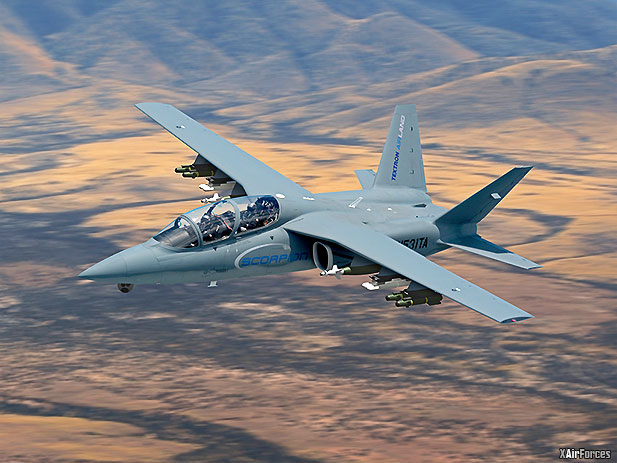
The Permissive Society

The airpower debate continues over the need for the United States Air Force (USAF) to field less sophisticated aircraft for the conduct of ground support missions to support future Counter-Insurgency operations (COIN).
Vocal advocates, including US Senator John McCain, chair of the US Senate Committee on the Armed Services, which overseas legislation pertaining to the country’s armed forces, appear to have been joined by the US Air Force chief of staff General David Goldfein and Lieutenant General James ‘Mike’ Holmes, the service’s deputy chief for strategic plans and requirements. In mid-January, Gen. Goldfein suggested that the USAF was engaged in a dialogue with interested potential industry partners and was considering “an experiment” to look into less expensive, lower flying cost aircraft. Also in mid-January, Mr. McCain published a white paper entitled Restoring American Power which recommended that the USAF: “should procure 300 low-cost, light attack fighters that would require minimal work to develop.” His paper continued that: “These aircraft could conduct (COIN) operations, perform close-air-support and other missions in a permissive environment.”
Funds are not currently budgeted and the OA-X, as it appears the experiment may be called, is not a formal programme. Yet the case for using such an aircraft for these missions as opposed to the USAF’s current McDonnell Douglas/Boeing F-15 family, and General Dynamics/Lockheed Martin F-16 family fighters, plus the McDonnell Douglas/Boeing F-18 family fighters operated by the US Navy and US Marine Corps is focused partly on operating costs. These high performance jets can run to $38846 per hour for an F-15D, according to USAF figures for 2015, as opposed to $1000 per hour for an Embraer EMB-314 Super Tucano turboprop trainer and light strike aircraft, according to media reports. Cost is not the only factor, airframe life degrades on frontline fighters as they perform air-to-ground operations which could be arguably performed just as easily using a less sophisticated airframe in a permissive air defence environment. Other factors include the ability of light strike aircraft to be based at more austere sites closer to the target areas, and to therefore be more responsive. For example, according to its manufacturer, the EMB-314 can operate from grass or dirt airstrips.
The Super Tucano entered service with the Brazilian Air Force in 1999 and has been continuously improved. It is fielded by over nine nations and has been successfully proven in counter-insurgency/terrorist combat operations. Credit Embraer.
A number of aircraft are potential candidates for the potential OA-X requirement, should it materialise into a programme of record, including turboprop and turbofan designs. In addition, it is not uncommon for these type of aircraft to be employed in a training role as well as being outfitted for light ground attack: The USAF has plans to acquire a new trainer as a result of the TX programme that is anticipated to commence by the end of 2017. Some of the TX candidate airframes, for example Textron’s Scorpion, advertise this capability. On the other hand , the Embraer/Sierra Nevada supplied EMB-314 has been already purchased by the USAF on behalf of the Afghan Air Force (AAF) under its Light Air Support project. Although the programme started in 2009 went through a series of protests, stop-work, cancellations and a re-award, the first aircraft were delivered to the AAF in 2016 and were conducting combat missions by March 2016.
It is not yet clear what the USAF OA-X requirement will contain nor the timeline they will propose. Gen. Goldfein and some of his staff’s statements have suggested a spring 2017 window. Still even Mr. McCain, who would clearly like to see this move aggressively forward, does not envisage aircraft entering the USAF fleet before 2022. A subset of the OA-X is the struggle between the USAF and the Congress over the retirement of the Fairchild Republic/Lockheed Martin A-10A/C Thunderbolt attack aircraft used by the USAF. This debate provoked a showdown between Mr. McCain and the then chief of the USAF, Gen. Mark Walsh during a hearing of the committee on 3rd March 2016 during which Gen. Walsh told the committee that the A-10A/C’s close air support role could be performed using F-15 and F-16 family aircraft. This triggered an robust response from Mr. McCain who argued that the USAF had nothing to replace the A-10A/C with: “otherwise (the USAF) would be using F-15s and F-16s (which it) has plenty of,” adding that the A-10A/C was in use to this end: “because it’s the most effective weapons system.” However, as aviation analysts have pointed out the A-10A/C was itself designed as an anti-amour weapons and not a COIN platform. That the A-10 is being seen as arguably the best available option for striking ISIS (Islamic State of Syria and Iraq) pick-up trucks in both the Iraqi and Syrian theatres may be in itself a sufficiently convincing argument for the OA-X to move forward smartly.
Source: By Stephen W. Miller - (asianmilitaryreview.com News) – February 20, 2017
Photo: Scorpion is a private development which first flew in December 2013. The USAF agreed to flight qualify the aircraft in 2016. It is anticipated to be a contender for the USAF TX trainer as well as the AO-X. Credit Textron AirLand. (Photo by Textron)
(9.03.2017)
|